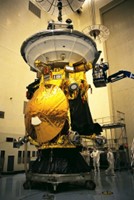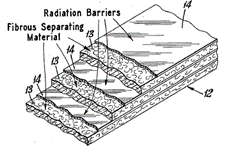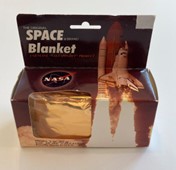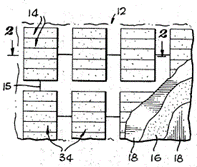
INNOVATE Magazine
INNOVATE is the online magazine by and for AIPLA members from IP law students all the way through retired practitioners. Designed as an online publication, INNOVATE features magazine-like articles on a wide variety of topics in IP law.
The views and opinions expressed in these articles are those of the authors and do not necessarily reflect the views or positions of AIPLA.
Articles
In This Section
Found in Space: Patented Technologies of NASA on Earth and Beyond
Elijah E. Cocks
“The aeronautical and space activities of the United States shall be conducted so as to contribute…to the expansion of human knowledge of phenomena in the atmosphere and space.…The [National Aeronautics and Space] Administration shall provide for the widest practicable and appropriate dissemination of information concerning its activities and the results thereof.”
- National Aeronautics and Space Act of 1958
Introduction
Space exploration takes innovation. Overcoming the challenges of reaching the final frontier requires constant development of creative solutions. Space agencies, like NASA, have generated and implemented novel technologies for many spacecraft applications, from Earth’s orbit to interstellar space. But what about the impact here on Earth of these technologies? The National Aeronautics and Space Act of 1958 (restated, amended and enacted in 2010 in Title 51 of the United States Code, “National and Commercial Space Programs”) mandates that NASA share its aeronautical and space innovations to contribute to the “expansion of human knowledge.”[1] From the NASA patents describing new space-related inventions to the infusions of resulting space technologies into the commercial sphere, this article briefly examines how NASA is fulfilling the information sharing mandate of its aeronautical and space activities for the “benefit of all humankind.”[2]
To Boldly Innovate…
From the inception of its information sharing mandate, NASA has embraced this statutory obligation. One way NASA has done this is through patents describing the newest space innovations. Beginning in 1969, NASA began public announcements of its granted patents in NASA’s Scientific and Technical Aerospace Reports (STAR). A few years later, in 1974, NASA began publishing the NASA Patent Abstracts Bibliography (NASA PAB) as a service for those “seeking new, licensable products for the commercial market.”[3] This effort has expanded today into the NASA Technology Transfer Program that is provided for the stated purpose to ensure “innovations developed for exploration and discovery are broadly available to the public.”[4] The Technology Transfer Program provides a public portal for identifying many NASA patents and technologies that are available for commercial license. Moreover, since 1976, NASA has published a magazine, Spinoff, to highlight NASA technologies that have been introduced commercially into society. Let us briefly examine just a few of the technologies developed by NASA for space applications that have seen commercial expansion, along with some of the related NASA patents that describe and publicly share details of those technologies.
Satellite Communications
Artist rendering of NASA’s Galileo spacecraft communicating with Earth after entering Jupiter’s orbit.[5]
Figure from U.S. Patent No. 3,988,677, granted Oct. 26, 1976, entitled “Space Communication System for Compressed Data with a Concatenated Reed-Solomon-Viterbi Coding Channel”
Artist rendering of satellites from the Tracking and Data Relay Satellite (TDRS) system in Earth’s orbit[11] |
Communication capability in space is critical. From far-flung spacecraft orbiting in the outer reaches of our solar system to those in Earth’s orbit, the ability to send and receive information accurately and efficiently to
and from these satellites is important. In the 1970s, NASA began developing an advanced communication system using compressed data and concatenated coding channels to provide error free communication at improved data transmission
rates. This technology was successfully implemented in both the Voyager 1 and 2 spacecraft and in the Galileo spacecraft on its mission to orbit Jupiter, and is now incorporated in the technical standards used in most spacecraft
communication systems.[6] Aspects of this communication technology are described in U.S. Patent No. 3,988,677 entitled “Space Communication System for Compressed Data with a Concatenated Reed-Solmon-Viterbi Coding Channel.”[7] In accordance with NASA’s information sharing mandate, this NASA patent, granted Oct. 26, 1976, states a primary object of describing
a new communication system for communicating data from a spacecraft to Earth and was reported in the NASA PAB.[8] The technology has progressed in the decades since, including development for many satellite applications in Earth’s orbit. For example, NASA’s Tracking and Data Relay Satellite (TDRS) system consists of a number of satellites in geosynchronous orbit that provide command, telemetry and science data between satellites and the ground, acting as information relays for many NASA missions. NASA continues to implement and share new modulation and coding innovations for this relay system.[9] Beyond NASA satellites, concatenated convolutional and Reed-Solomon channel coding technology is used globally by most commercial satellite operators for television and data broadcasting services, and the technology continues to see progressive advancements.[10] |
Digital Imaging
Pictures from space are often extraordinary. Whether a strange view of a vibrant galaxy or a landscape from the surface of a distant world, space images can be impactful and even emotionally resonating. NASA has long recognized
the need for space imaging for scientific purposes as well as public interest. A seminal camera imaging innovation for space applications is described in U.S. Patent No. 5,471,515, granted Nov. 28, 1995, entitled “Active Pixel Sensor with Intra-Pixel Charge Transfer.” This patent details a new design
for a silicon imaging device which can be fabricated using a complementary metal oxide semiconductor (CMOS) process. [13] An
advance over the use of known charge-coupled devices (CCD) for imaging, this innovation, developed at the Jet Propulsion Laboratory under a NASA contract, uses a technique for intra-pixel charge transfer that allows for improved imaging
using less power than CCD devices and that can be readily integrated into a computer chip. The digital imaging capability enabled by this CMOS technology was a major development in producing small, low-power cameras, perfect for incorporation into consumer electronics. It has become one of the most omnipresent spinoff technologies from NASA that is used in nearly all smartphone cameras today.[14] |
Picture of the Perseverance rover on the surface of Mars, taken as a selfie using the WATSON (Wide Angle Topographic Sensor for Operations and eNgineering) camera on the end of the rover’s two-meter-long robotic arm[15]
Digital imaging using a smartphone camera [16] |
Thermal Insulation and Space Blankets
The Cassini spacecraft and attached Huygens probe, both with gold-colored thermal insulation blankets[17]
Figure from U.S. Patent No. 3,007,596, granted Nov. 7, 1961, entitled “Thermal Insulation”
“Space Blanket” from the 1980s, identified as “A GENUINE ‘NASA SPIN-OFF’ PRODUCT”[22] |
The temperature of a spacecraft can fluctuate dramatically depending on sun exposure. As a result, spacecraft need to be thermally insulated to mitigate the extreme temperature changes in space and to protect onboard equipment.
For example, NASA’s Cassini spacecraft on its mission to Saturn, with attached Huygens probe from the European Space Agency that landed on Saturn’s moon Titan, experienced temperature ranges from 482 to minus 364 degrees
Fahrenheit (250 to minus 220 degrees Celsius). [18]
Anticipating this, NASA protected much of the spacecraft and probe by thin, gold-colored, reflective aluminized thermal insulation blankets. Investigating thin, reflective insulation materials was a particular focus for NASA and its contractors for manned space programs in the 1960s. Developed especially for the Apollo program, these insulation materials quickly became
technology widely employed for thermal control on many spacecraft. U.S. Patent No. 3,007,596, granted Nov. 7, 1961, entitled “Thermal Insulation,” developed under a NASA contract, describes techniques for producing
thin aluminum foils supported by fiber sheets as reflective, multilayer insulation coverings. [19] This
technology was dubbed “superinsulation.”[20] By the 1980s, the benefit and practicality of thin superinsulation blankets for commercial applications had gained traction, particularly for emergency preparedness and outdoor enthusiasts. The “Space Blanket,” as it
was commonly termed, became one of the first widely-known NASA spinoff technologies to reach the public consciousness in multiple forms of commercial products, from souvenirs to marathon blankets. [21] |
Solar Energy
A spacecraft needs power to operate. On missions to the inner planets, the sun is a viable option for providing necessary power using solar panels arranged in arrays to generate electricity from sunlight. Not only spacecraft,
but landers, like Mars Pathfinder, and rovers, like Sojourner, Spirit and Opportunity, have all harnessed the sun’s energy on the surface of Mars using solar arrays. Closer to home, Earth-orbiting space vehicles are also
perfectly situated for utilizing solar energy, such as the International Space Station (ISS) that generates power from eight main solar arrays, along with a new type of roll-out solar array recently installed by NASA on the ISS for
additional power generation.[23] NASA has been developing and improving solar panels and their manufacture for decades for space-related purposes. For example, U.S. Patent No. 3,565,719, granted Feb. 23, 1971, entitled “Solar Panel Fabrication,” describes
a method of fabricating solar cells on a substrate in a manner designed to achieve the high reliability required for solar power generation in space. [24]
Upon grant, this patent was reported by NASA in its STAR announcement for information dissemination purposes.[25] The advances in solar panel technology by NASA and many others over the last decades have produced abundant efforts and initiatives directed to helping meet the electricity requirements of society using solar power generation. It has been estimated that in 2022 nearly 1300 terawatt hours (TWh) of energy was generated globally by solar power.[26] Looking forward, NASA continues to boldly innovate for the future use of solar power to help meet energy needs here on Earth. Recently, NASA has considered tantalizing new concepts for generating space-based solar power, including delivering microwave energy to Earth from solar energy collected in space, driving forward technologies where no one has innovated before. [27] |
Existing solar panels on the ISS along with installation of a new roll-out type of solar array[28]
Figure from U.S. Patent No. 3,565,719, granted Feb. 23, 1971, entitled “Solar Panel Fabrication”
Space-based solar power concepts by NASA to deliver microwave energy to Earth from solar energy collected in space[29] |
Information Legacy
Many of our spacecraft, and their onboard technologies, are destined to wander the cosmos for eons. For today, NASA’s ongoing fulfillment of its information sharing mandate for these space technologies, through patents and publications, has enabled proliferation of NASA’s space-related knowledge and information into society for the benefit of all. One might even say NASA has extended the scope of its information sharing beyond Earth. From a team led by the late Carl Sagan, a gold-plated information record was created and affixed to each of the Voyager 1 and 2 spacecraft for their journeys out of our solar system. Replete with images and sounds from Earth, and with pictographic instructions for obtaining the data, this interstellar “Golden Record” is carried by our space emissaries to destinations unknown. As said by Carl Sagan: “No one sends such a message on such a journey without a positive passion for the future.” [30] The passion for and pursuit of information and knowledge by NASA and others for the benefit of all of humanity is a legacy that progresses inexorably onward.

The interstellar Golden Record aboard each of the Voyager 1 and 2 spacecraft[31]
[1] “National Aeronautics and Space Act of 1958,” Public Law #85-568, 72 Stat., 426, §§102(c), 202(a)(3): www.nasa.gov/history/national-aeronautics-and-space-act-of-1958-unamended; restated and amended, Pub. L. 111–314, §3, Dec. 18, 2010, 124 Stat. 3330, enacted in Title 51 USC, “National and Commercial Space Programs.”
[2] Id., 51 USC §20102(a).
[3] “NASA Patent Abstracts Bibliography: A Continuing Bibliography,” Section 2: Indexes, NASA-SP-7039(04), Jan 1974: ntrs.nasa.gov/citations/19740012497
[4] NASA Technology Transfer Program: technology.nasa.gov (last visited 09 May 2024).
[5] Image from images.nasa.gov/details/ARC-1986-AC86-0038-1. Credit: NASA.
[6] R. Rice, “Mission Science Value/Cost Savings from the Advanced Imaging Communication System (AICS),” JPL PUB 84-33 / NASA-CR-174170, July 15, 1984: ntrs.nasa.gov/citations/19850004597.
[7] U.S. Patent No. 3,988,677, Inventors Rice et al., granted Oct. 26, 1976, “Space Communication System for Compressed Data with a Concatenated Reed-Solomon-Viterbi Coding Channel.” Assigned to NASA. See www.uspto.gov.
[8] “NASA Patent Abstracts Bibliography: A Continuing Bibliography,” Section 1: Abstracts, NASA SP-7039(11), pp. 16-17, Jul 1977:
[9] Y. Wong et al., “Advanced Modulation & Coding Techniques for TDRSS S-Band Services,” AIAA 2010-1917: arc.aiaa.org/doi/pdfplus/10.2514/6.2010-1917
[10] ETSI EN 302 307 V1.2.1 (2009-08), European Standard (Telecommunications series), “Digital Video Broadcasting (DVB); Second generation framing structure, channel coding and modulation systems for Broadcasting, Interactive Services, News Gathering and other broadband satellite applications (DVB-S2),” 2009, p. 6: www.etsi.org/deliver/etsi_en/302300_302399/302307/01.02.01_60/en_302307v010201p.pdf
[11] Image from images.nasa.gov/details/S90-41340. Credit: NASA.
[12] J.N. Maki et al., “The Mars 2020 Engineering Cameras and Microphone on the Perseverance Rover: A Next-Generation Imaging System for Mars Exploration,” Space Sci Rev (2020) 216:137: doi.org/10.1007/s11214-020-00765-9.
[13] U.S. Patent No. 5,471,515, Inventors Fossum et al., granted Nov. 28, 1995, “Active Pixel Sensor with Intra-Pixel Charge Transfer.” Assigned to California Institute of Technology; work performed under a NASA contract. See www.uspto.gov.
[14] “CMOS Sensors Enable Phone Cameras, HD Video,” NASA Spinoff, 2017: spinoff.nasa.gov/Spinoff2017/cg_1.html
[15] Image from images.nasa.gov/details/PIA24836. Credit: NASA/JPL-Caltech/MSSS.
[16] Image from commons.wikimedia.org/wiki/File:Handyaufnahme_des_Sonnenuntergangs_als_Zeitraffer_20200909_DSC3277.jpg. CC BY-4.0 Credit: PantheraLeo1359531.
[17] Image from images.nasa.gov/details/KSC-97PC1350. Credit: NASA.
[18] NASA Science Missions, Cassini - Thermal Blankets: science.nasa.gov/mission/cassini/thermal-blankets) (last visited 09 May 2024.
[19] U.S. Patent No. 3,007,596, Inventor L. Matsch, granted Nov. 7, 1961, “Thermal Insulation.” Assigned to Union Carbide Corporation; developed under contract with NASA. See www.uspto.gov.
[20] “Reflective Superinsulation Materials,” Applications of Aerospace Technology (NASA CR-2507), prepared by Midwest Research Institute for NASA Technology Utilization Office, 37 pp., p. 6, Jan. 1975: ntrs.nasa.gov/api/citations/19750006837/downloads/19750006837.pdf
[21] “Reflecting on Space Benefits: A Shining Example,” NASA Spinoff, 2006: spinoff.nasa.gov/Spinoff2006/ch_9.html
[22] Author’s collection.
[23] “Impact Story: Roll-Out Solar Arrays,” NASA Space Technology Mission Directorate (STMD), Mar. 31, 2022: www.nasa.gov/directorates/stmd/impact-story-roll-out-solar-arrays
[24] U.S. Patent No. 3,565,719, Inventor P. S. Du Pont, granted Feb. 23, 1971, “Solar Panel Fabrication.” Assigned to NASA/Hughes Aircraft Co.; made in performance of work under a NASA contract. See www.uspto.gov.
[25] NASA Technical Reports Server, Document ID 19710017250: ntrs.nasa.gov/citations/19710017250.
[26] “Tracking Solar PV,” International Energy Agency: www.iea.org/energy-system/renewables/solar-pv (last visited 09 May 2024).
[27] E. Rodgers et al., “Space-Based Solar Power,” NASA Office of Technology, Policy and Strategy, Report ID 20230018600, 108 pp., Jan. 11, 2024: www.nasa.gov/wp-content/uploads/2024/01/otps-sbsp-report-final-tagged-approved-1-8-24-tagged-v2.pdf?emrc=744da1
[28] Image from images.nasa.gov/details/iss065e124482. Credit: NASA
[29] Image from Rodgers et al, Space-Based Solar Power. Credit: NASA.
[30] Carl Sagan et al., “Murmurs of Earth: The Voyager Interstellar Record,” Random House, 1978.
[31] Image from images.nasa.gov/details/PIA14113. Credit: NASA/JPL-Caltech.
Innovate Volume 19 Timeline
submit articles to innovate@aipla.org
Submission Window Open
August 1
Submission Deadline
October 31
Publication Date
December 12, 2025
About
Publishing an article to INNOVATE is a great way for AIPLA members to build their brand by increasing recognition among peers and setting themselves apart as thought leaders in the IP industry.
Any current AIPLA member in good standing may submit an article for consideration in INNOVATE throughout the year. IP law students are especially encouraged to submit articles for publication.
Articles submitted to innovate@aipla.org are reviewed by an ad-hoc sub-committee of volunteers from AIPLA's Fellows Committee, and other AIPLA peers.
Don’t miss your chance to be published with AIPLA’s INNOVATE! Email your article submission to innovate@aipla.org to be considered for the next edition.
For more information please review the Guidelines for INNOVATE Article Submission and the INNOVATE Author Acknowledgement Letter for guidelines and terms of article submission and publication.





 Figure from U.S. Patent No. 5,471,515, granted Nov. 28, 1995, entitled “Active Pixel Sensor with Intra-Pixel Charge Transfer”
Figure from U.S. Patent No. 5,471,515, granted Nov. 28, 1995, entitled “Active Pixel Sensor with Intra-Pixel Charge Transfer”





